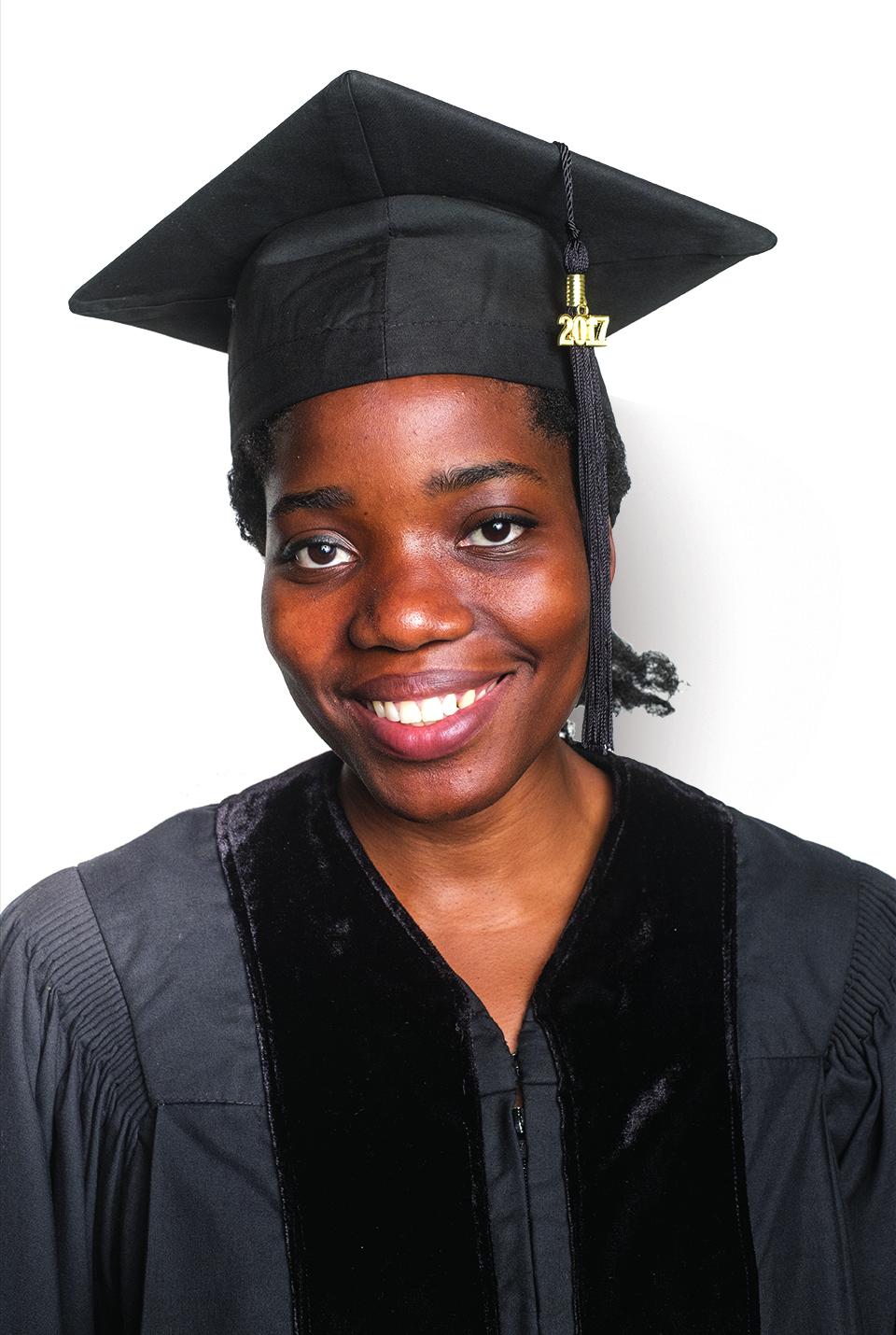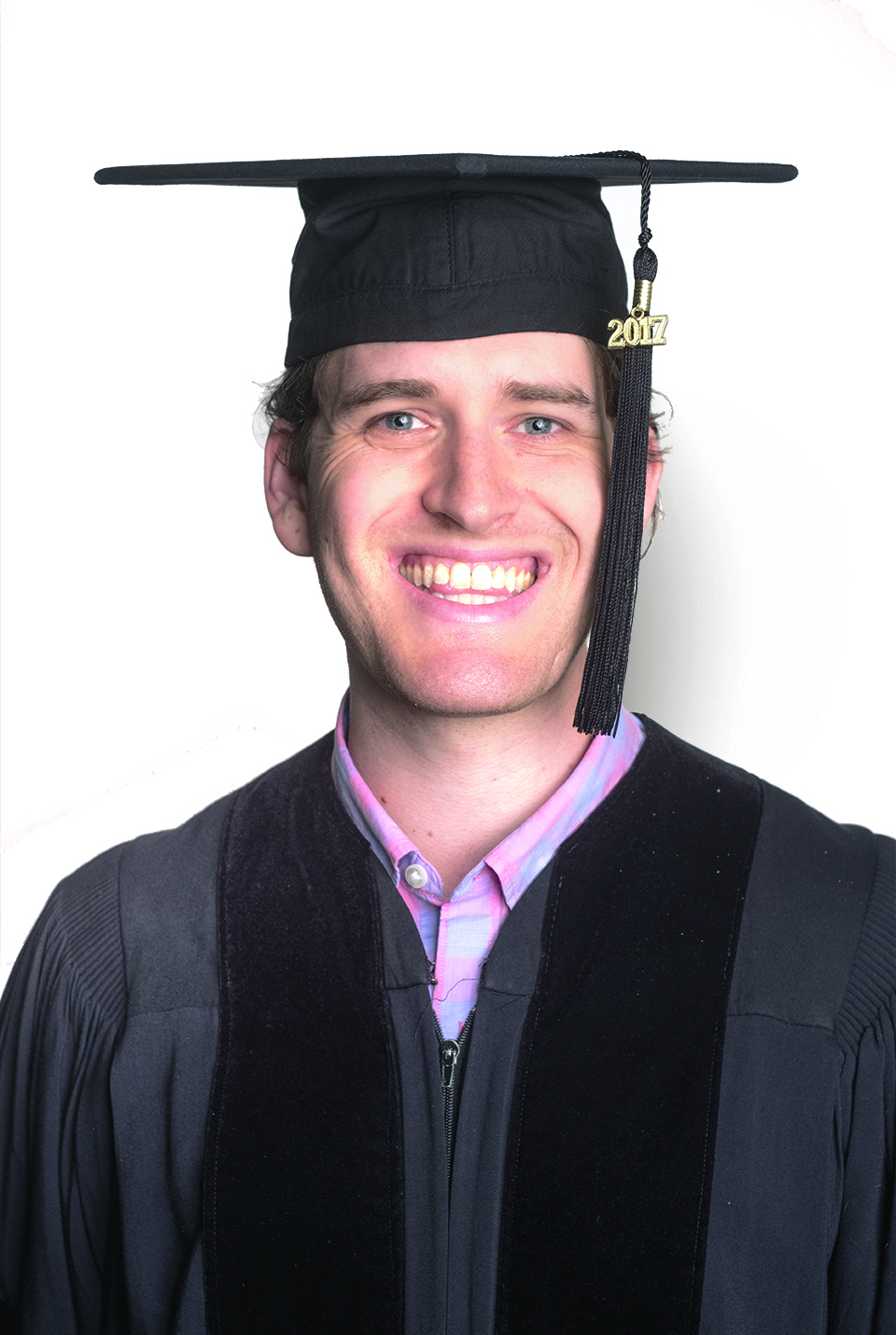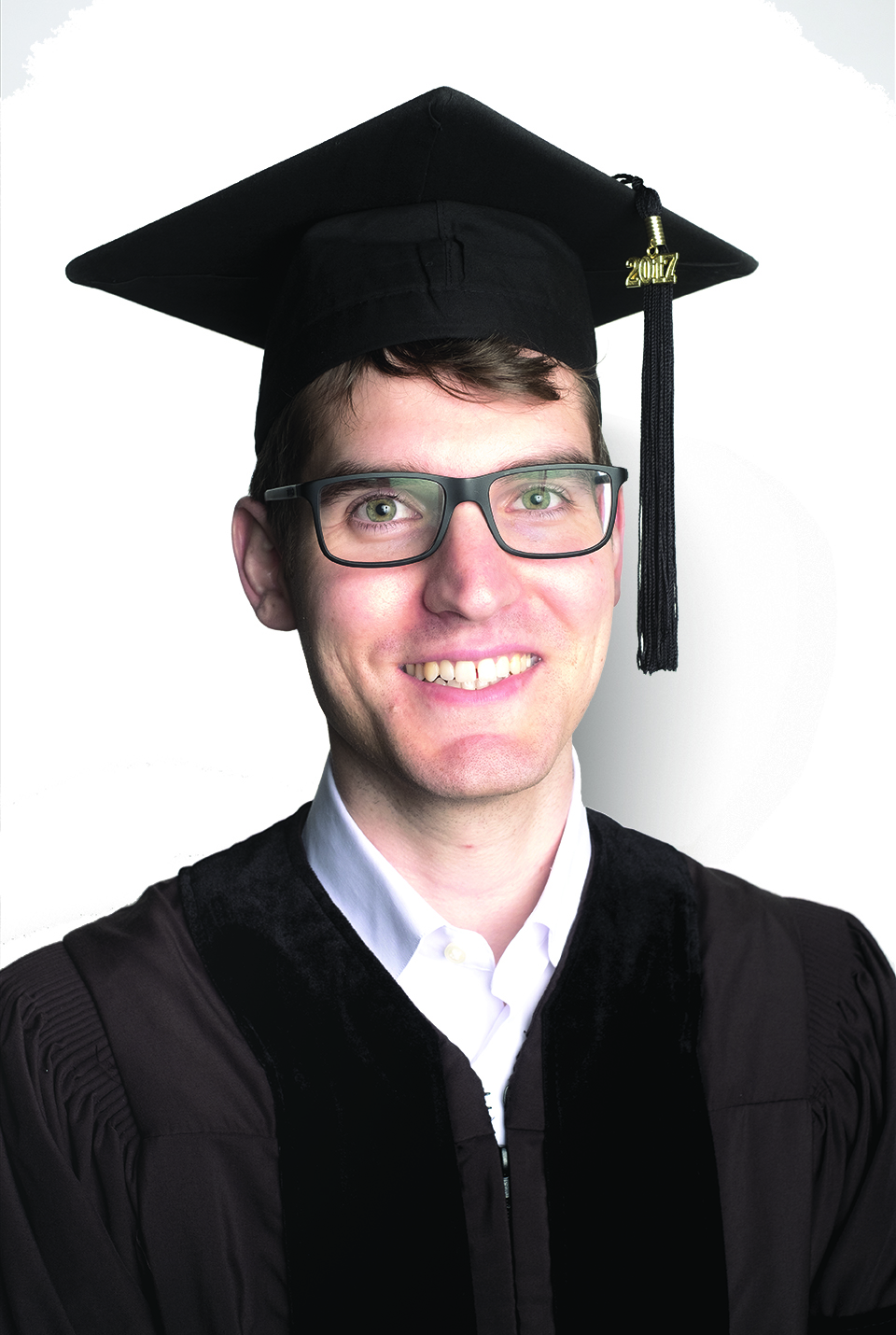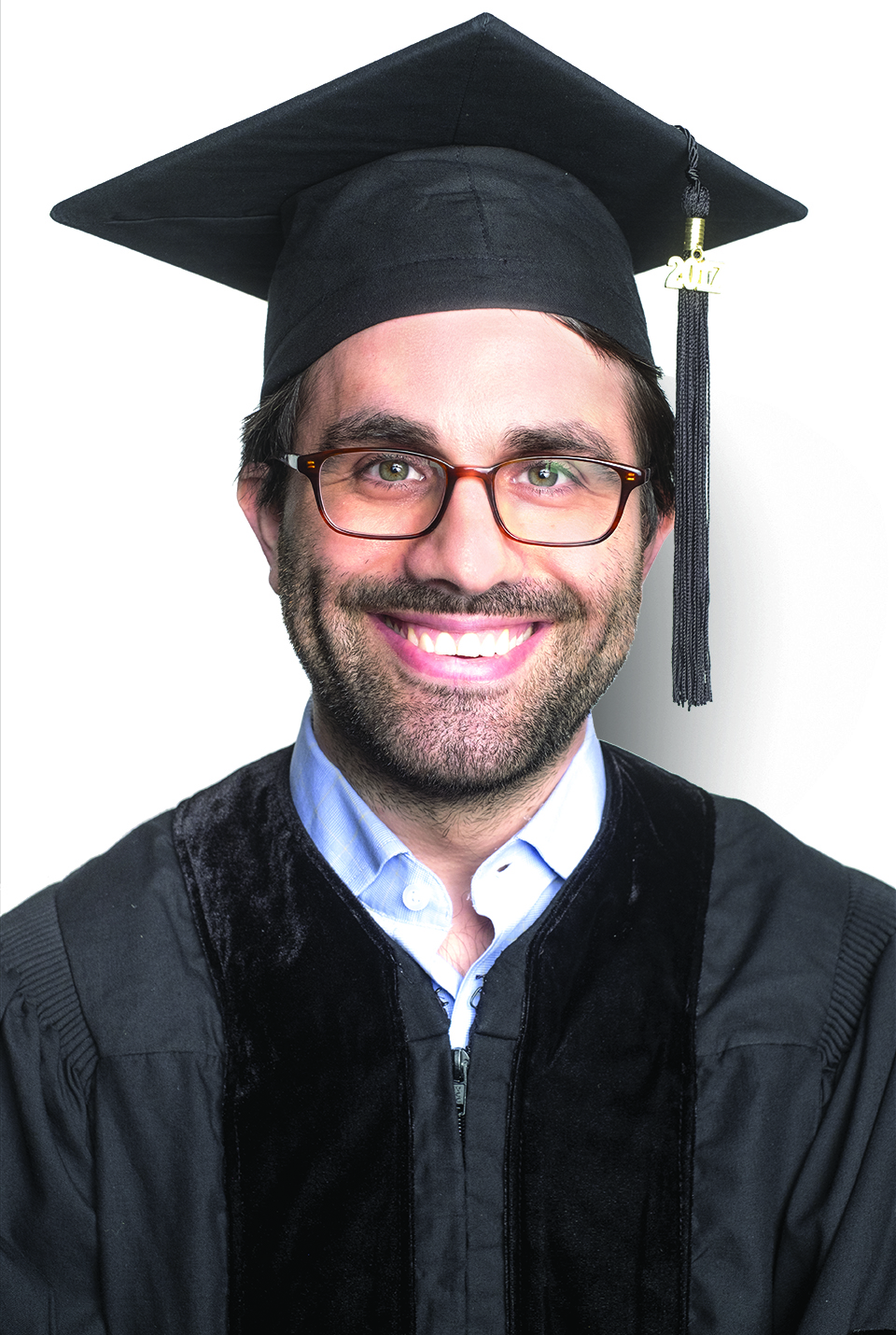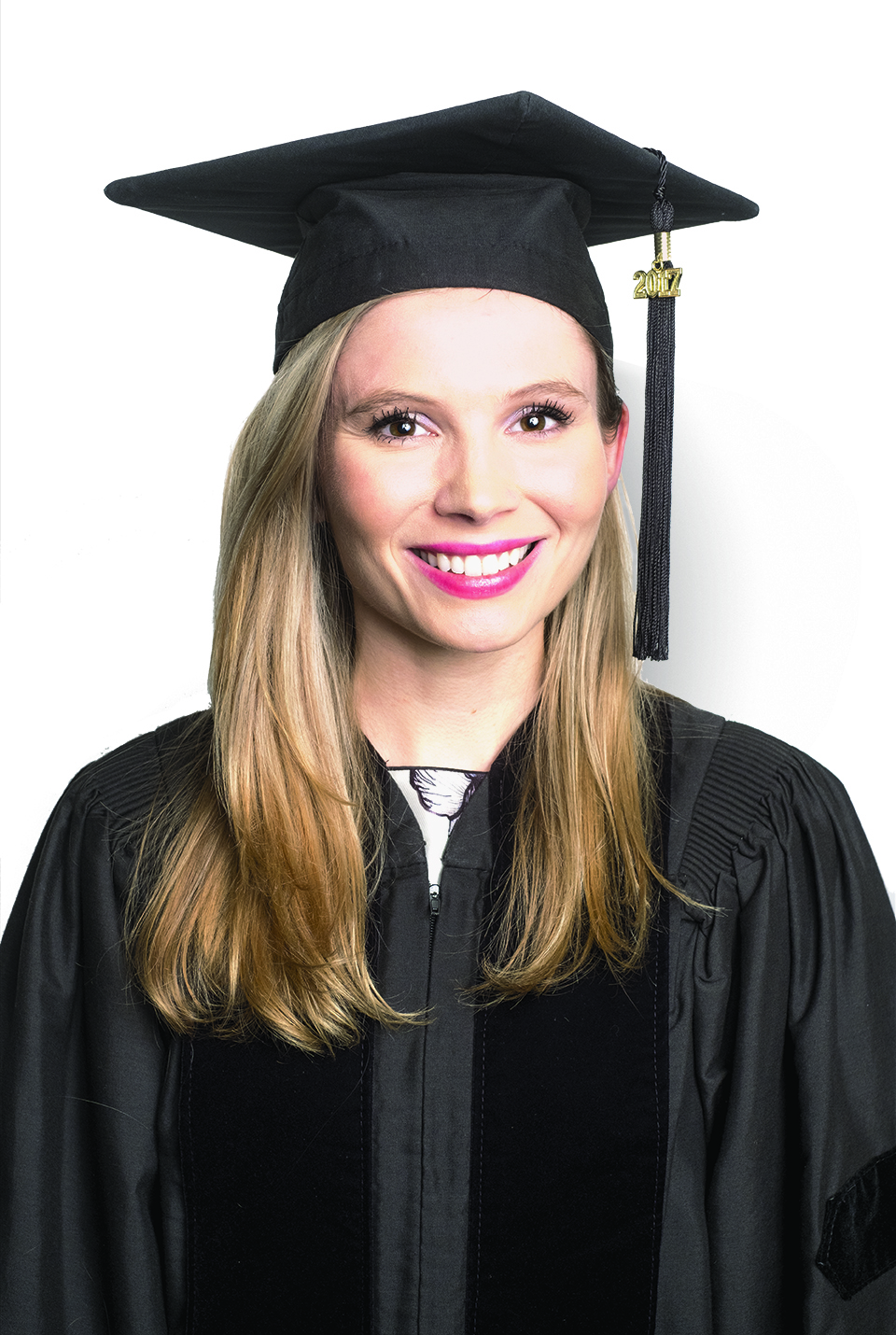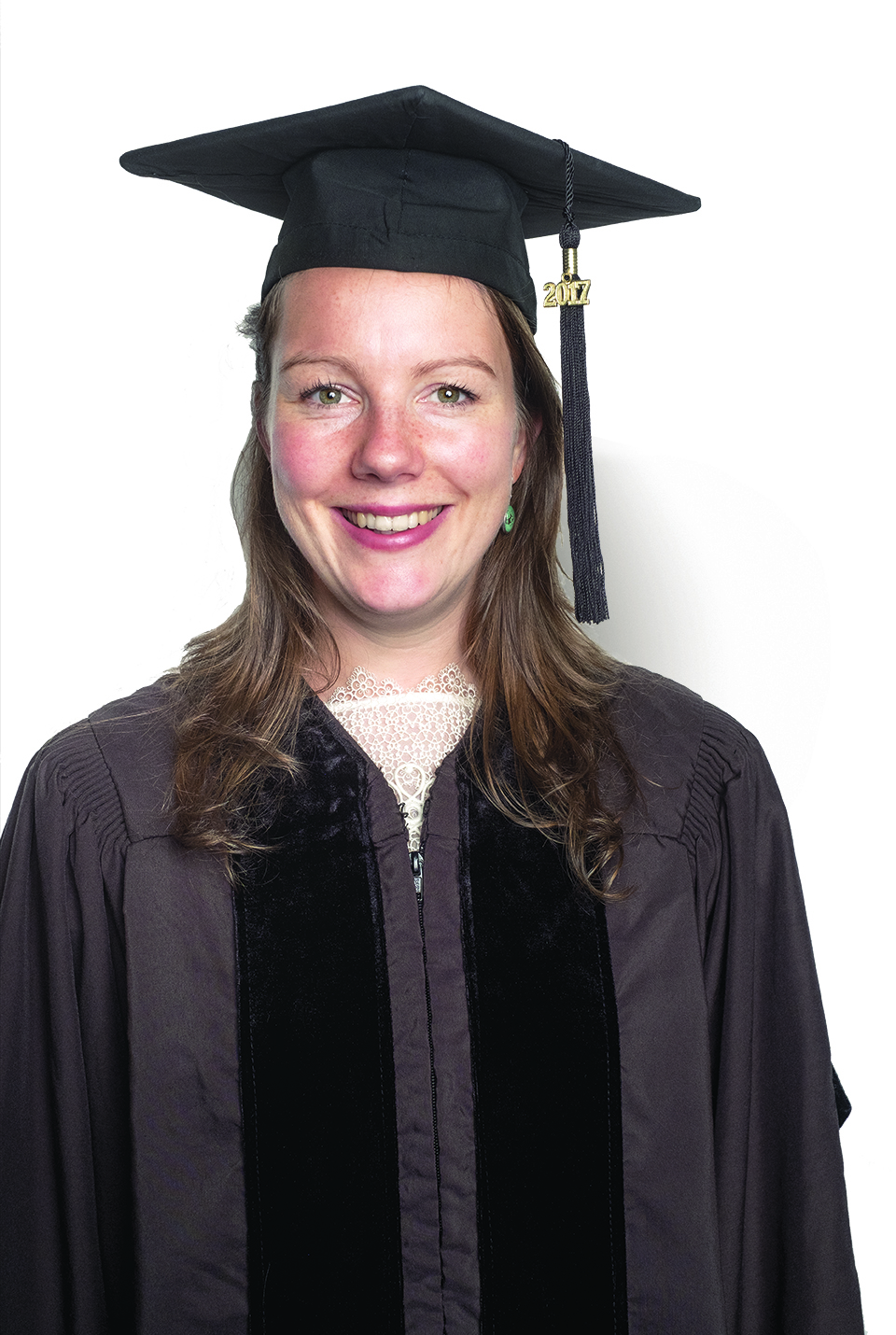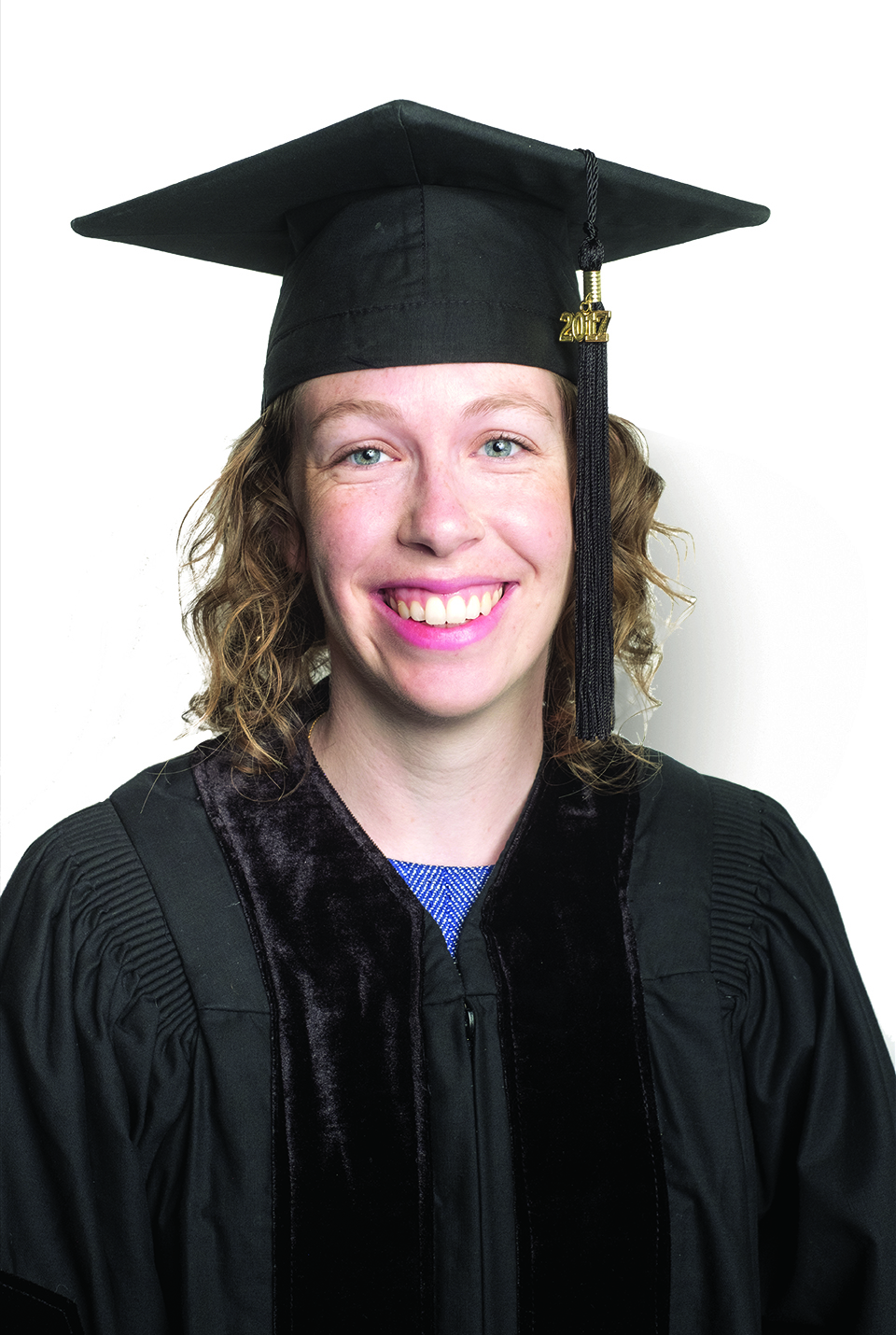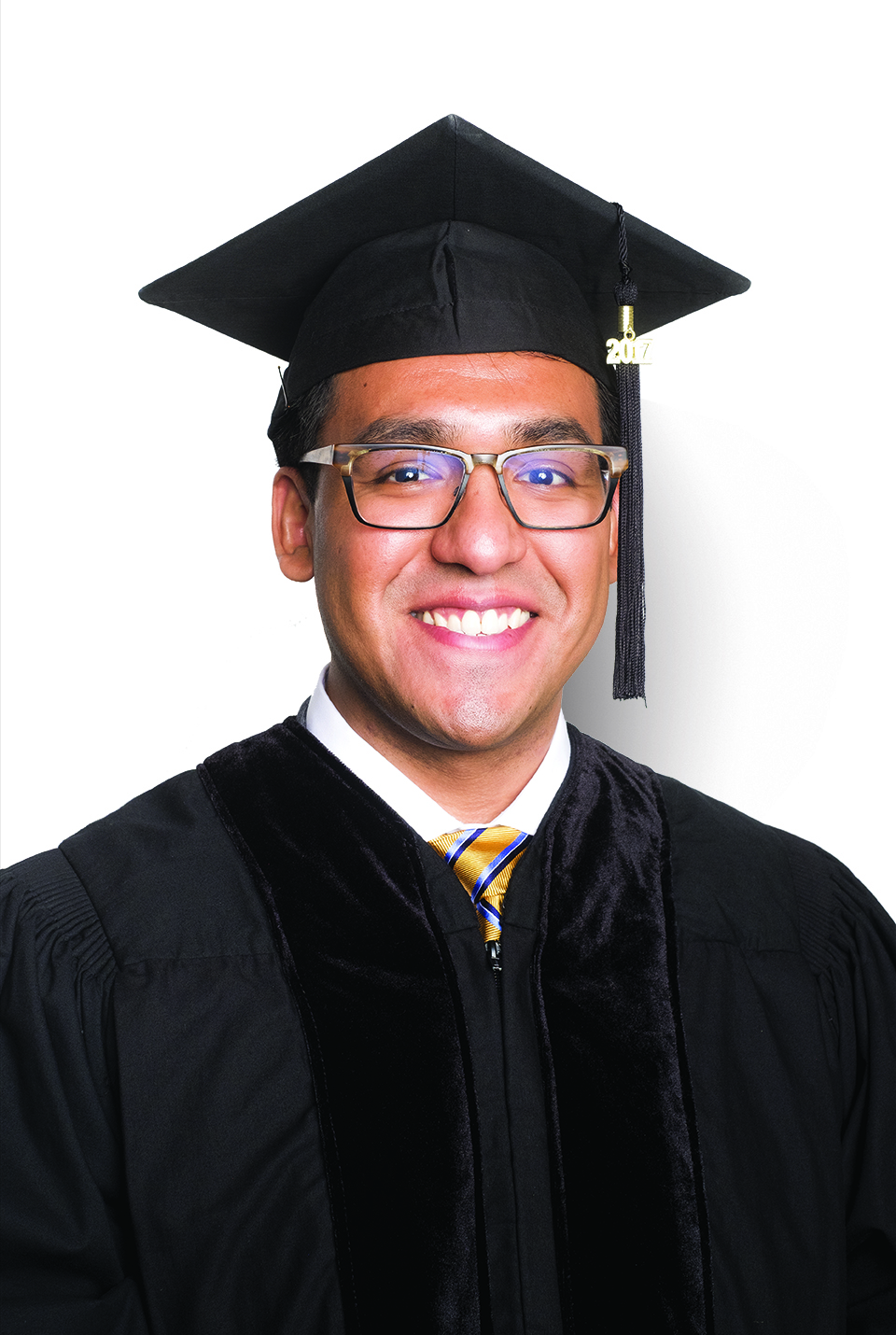During the Convocation ceremony, Rockefeller faculty commended their students for their scientific contributions, untiring work, and unique skills. Below are the highlights from congratulatory tributes given to each of the 2017 graduates, including students in the Tri-Institutional M.D.-Ph.D. Program (denoted with an asterisk).
Five students graduated in absentia: Julien Babak Azimzadeh*, Deanna Belsky, Peter Insley, Supawat Thongthip, and Donovan Ventimiglia.
Rene C. Adam
presented by Elaine Fuchs
Home Sweet Home: Epigenetic Paths of Stem Cells in and out of Their Niche
Every so often, a truly special young scientist comes to the laboratory and shines as a rising star. Rene Adam is such a student. For his thesis research, Rene became passionate about the stem cells of hair follicles, positing that the transcription factors specifically expressed by these cells might work together to control the critical genes that give these long-lived skin stem cells their remarkable ability to grow hair. He performed a technique known as high throughput chromatin immunoprecipitation and deep sequencing, or ChIP-seq, to identify which genes contained regulatory elements that were bound by the entire cohort of the hair stem cell transcription factors. Representing only approximately five percent of all the genes expressed by these stem cells, Rene’s shortlist contained nearly every gene we and others knew to be important for hair growth in mice and in humans. The work was published in Nature to high acclaim. Rene’s passion and talent at the bench are matched by his intellect and creativity. I’m delighted to have had the opportunity to mentor Rene over these years.
Amma Ami Asare*
presented by Elaine Fuchs
Investigating Differentiation: A Role for Organelle Inheritance in Epidermal Growth
Amma hits on all cylinders—she is smart, creative, and independent, but at the same time has excellent hands at the lab bench and outstanding interactive skills. Her thesis research was aimed at elucidating how the epidermis develops and maintains the skin’s barrier that keeps harmful microbes out and retains body fluids. She devised a system that allowed her to identify the earliest changes in gene expression that occur as a proliferative epidermal stem cell stops dividing and begins its program to create the protective dead cells at our skin surface. She then set up a clever genetic screen in mice that allowed her to sift through these many changes and figure out which ones were the most important. She discovered a novel mechanism that proliferative cells use to make sure each daughter cell gets its fair share of its parents’ organelles, work that was published in Science earlier this year. Amma is quite simply one of the brightest and most impressive aspiring physician-scientists I’ve ever known.
Matthew Dornfeld
presented by George N. Reeke Jr. on behalf of Marcelo O. Magnasco
The Physics of Rodent Ultrasonic Vocalizations
Matthew joined the Magnasco lab with an interest in computational neuroscience, and quickly became intrigued by the field of rat ultrasonic vocalizations. The voices of animals have long been the subject of much interest in biology. Matthew undertook a study in which he automatically tracked a huge number of rat vocalizations and analyzed them for sudden frequency jumps, gathering massive statistics. He quickly discovered that very little was known about what mechanisms produce which jumps. He later studied the physical mechanism that could generate statistics like in those jumps, and this led him down a path in which he got himself into some seriously deep and brain-boggling hydrodynamics. Matthew’s work beautifully exemplifies the unpredictability of the scientific enterprise, where you start looking at one phenomenon, and as you try pulling threads out, you are led far astray, into alien uncharted territory. Matthew unflinchingly followed the science far away from his starting point, wherever it led him, just to get to the bottom of the question.
Jonathan Green
presented by Gaby Maimon
A Neuronal Circuit Architecture for Angular Integration in Drosophila
I first met Jonathan when he stopped by my office a few years back to discuss a possible rotation. He was immensely creative, even from day one. In his thesis work, Jonathan discovered that tiny fruit fly brains, remarkably, contain several classes of head-direction-like compass cells, which provide flies with a sense of orientation. He further described how these compass cells form an interconnected circuit, which explains how flies update their sense of orientation based on how fast they are turning left or right. Because the circuit by which mammals update their sense of orientation is still not known, Jonathan’s work in flies provided the first glimpse of how any brain computes angular heading. His insights may help us better understand how the mammalian orientation system works—perhaps even the human orientation system—sooner than one might think. Jonathan was the first student to join my lab, and his technical and biological insights were truly phenomenal. His scientific work will impact the trajectory of my group for many years to come.
Josh S. Greene*
presented by Cori Bargmann
Density-dependent Foraging in Caenorhabditis elegans
How do animals detect each other and incorporate this information into behavior at the biological level of genes and the brain? In his Ph.D. work, Josh unraveled this mystery beginning with a discovery that different wild-type individuals of the species we study, C. elegans, behave differently. Some modify their behaviors as animal density increases. Others initially appeared oblivious, although Josh later found that they knew more than they let on. Josh discovered that this difference in behavior results from genetic differences affecting two adjacent genes. He also found that different kinds of animals are more or less successful depending on what other animals are around, and how much food is present. This result fits the evolutionary prediction from game theory, which posits that the best strategy depends on what other animals are doing. Josh’s own behavior has been more than optimal, resulting in exciting discoveries in areas far beyond those that we expected: molecular neuroscience, population genetics, evolutionary fitness. He has excelled in his creativity and intellectual mastery of deep biological questions.
Elizabeth Hubin
presented Seth A. Darst
Structural and Functional Studies of Mycobacterial General Transcription Factors RbpA and CarD
In our laboratory, we study how cells make RNA from the genetic information encoded in DNA. Much of our focus is on a molecular machine responsible for this process, called the RNA polymerase. The paradigm within which we understand the process has been developed from studies of E. coli. It’s been assumed that what we learn from E. coli applies to other bacteria as well. Lizzy’s work has shown that this assumption is wrong. Elizabeth Campbell, who is leading research in our lab to understand the transcription program in Mycobacterium tuberculosis—which causes tuberculosis and infects one-third of the world’s population—and Lizzy worked closely together to forge major advances in our understanding of the mycobacterial transcription process, including determining the first and most detailed structure of a mycobacterial transcription initiation complex, containing six proteins, DNA, and RNA. Lizzy has left the lab but her influence persists: We’re now building on her work to learn how antibiotics block the mycobacterial RNA polymerase and how the RNA polymerase in turn develops resistance.
Sasa Jereb
presented by Robert B. Darnell
Deconvoluting Cell-type Specific 3’UTR Isoform Expression in the Adult and Developing Cerebellum
Saša is interested in doing creative science that can be applied, using state-of-the-art technology, for the good of humankind. Her education here has underscored these interests. She has taken courses ranging from chromatin biology and epigenetics to neural systems, and a survey course in RNA given by my father, James Darnell, a Rockefeller professor emeritus. He wrote to Saša, after reviewing her final course paper, “Your paper proves you are a biologist in the modern world.” For her thesis, Saša studied the brain at a previously unprecedented level of detail. Working with a postdoctoral fellow, Hun-Way Hwang, she applied an entirely new platform technology to understand cell-specific neuronal biology. She developed ways to study how choices are made in generating mRNA copies from genes—alternative polyadenylation—in specific cell types in the adult cerebellum and during its development. Saša’s work provides a breakthrough in what is emerging as a hot area of interest—a new approach to understanding all of the differences in the trillions of cells in our bodies.
Roos Karssemeijer
presented Titia de Lange
Pathways of Non-homologous End Joining at Dysfunctional Telomeres and Their Resolution
When Roos came to Rockefeller, she was solidly committed to immunology. In the fall of 2013, however, she joined my lab to work on our project on the interface between the DNA damage response and telomere biology. Her experimental prowess allowed her to make this shift swiftly and successfully. Roos received a fellowship from the German Boehringer Ingelheim Fund and was supported by a Women & Science Graduate Fellowship. She has co-authored seven peer-reviewed publications with at least one more to come. Roos’s scientific achievements are matched by her remarkable athletic abilities: She has run several marathons, including a 54-kilometer ultra-marathon on Mont Blanc in the French Alps, a race that includes a change in elevation of 12,000 feet. Roos was born to run, and she is now running around Boston, where she works at McKinsey & Company. The lab misses seeing Roos at the bench in her running gear, rarely breaking a sweat either while pounding the pavement or hammering out data.
Kenneth Lay
presented by Elaine Fuchs
Transcriptional Governance of Hair Follicle Stem Cell Quiescence and Niche Maintenance in Long-term Tissue Regeneration
Elected into Singapore’s prestigious “ASTAR” program for the best and brightest students, Kenneth decided to go to Imperial College of London, where he received his undergraduate degree. The experience was a sea change. In Kenneth’s words, “My newfound appreciation for science and its self-perpetuating quality, which generate an endless quest for knowledge, cemented my goal to obtain a Ph.D. and become a full-fledged explorer of nature.” For his thesis research, Kenneth became passionate about FOXC1, a transcription factor expressed in resting hair follicles. Kenneth “woke up” these hair follicles in mice by removing their Foxc1 gene. After that, the hair follicles spent no time at all at rest. They just kept cranking out cycles of hair growth. At first, it seemed as though Kenneth may have stumbled into the Fountain of Youth. But as the mice aged, their hairs got grey and sparse. Kenneth showed that when hair stem cells are used constantly, they run out of gas. The story is a beautiful one, and Kenneth’s thesis defense was mesmerizing. Motivation is something that you cannot teach. Kenneth has it, and he has applied it well.
Tamara Ouspenskaia
presented by Elaine Fuchs
Mechanisms of Stem Cell Specification during Organ Morphogenesis
When Tamara began her Ph.D. studies, she was already at ease with asking bold questions, developing hypotheses, and testing her ideas at the bench. For her thesis project, she wanted to know how progenitor skin cells make hair follicles. She discovered that a special signaling pathway, called WNT, is essential. When skin cells receive this WNT signal, they cluster. Then they divide perpendicularly to the skin surface to make a hair bud. This division angle imparts different fates to the daughter cells: a WNT-high daughter cell remains where its parent is, but the WNT-low daughter cell is expelled. It turns out that kicking the kid out of the house is what it needs to develop the special skills that make it a long-lived stem cell. Survival of the fittest in its prime! Tamara is genuinely intrigued by science, and she is one of the most upbeat students I ever had the pleasure to mentor. I miss her laugh, as her bench was right next to my office. Her joy for science filled the lab.
Jennifer Carol Peele
presented by Thomas P. Sakmar
Isopeptide and Ester Bond Ubiquitination Regulate Degradation of the Human Dopamine Receptor 4
Jenny made such a positive impression at the end of her rotation in my lab that I was confronted by a group of other students and postdocs, who implored me to convince her to join our group. That has only happened once in 25 years. Jenny’s thesis work broke new ground in elucidating how an interesting receptor, called the D4 dopamine receptor, is transported and then degraded in neurons. Genetic variations in the D4 receptor are thought to be responsible for thrill-seeking personality traits in humans. So much so, that an advertisement once featured a BMW with a license plate labeled D4R8—the thrill seeker’s genotype. Jenny showed that a new type of chemical modification involving ubiquitin was linked to D4R to enhance its turnover, work that won her a prestigious National Science Foundation fellowship award. She also mentored high school and college students here at Rockefeller and designed and taught a new course in biology for non-science majors at Marymount College. Jenny plans to pursue academics and teaching, and her passion will certainly inspire a new generation of scientists.
Violeta Rayon Estrada
presented by F. Nina Papavasiliou
APOBEC1-mediated RNA Editing in Monocytes Contributes to Genetic Heterogeneity and Modulates Monocyte Activity and Development
RNA editing was first described in the 1980s as a curiosity that affected the transcript that encodes glutamate receptors. Now, in part because of Violeta’s work, we know that editing is far more frequent than anyone had anticipated, and that it is used by a variety of cells and organisms to drive informational diversity. But when Violeta first started in the lab, the field of epitranscriptomics, which describes RNA editing and modification events as they impact transcript fate, did not exist. It wasn’t easy to be at the forefront of a field that was not yet a field. Experiments were not always straightforward—in fact, they were often at the cutting edge of what was experimentally possible. But Violeta persisted, and her work has helped frame a field and move it from cataloging editing events to attempting to understand the functional relevance of epitranscriptomic changes for the transcript, the cell, and eventually the organism itself. Violeta plans to continue her work in the field whose parameters she helped frame, now in the context of human disease.
Carlos Rico
presented by Thomas P. Sakmar
Single Molecule Ligand Binding Studies on CCR5 by Fluorescence Cross-correlation Spectroscopy
The story of Carlos Rico is an American success story. He first came to the U.S. at age 12 from Mexico. He entered the L.A. public school system without speaking English, and accepted a scholarship to Hamilton College. Carlos came here with an ambitious research program to study G protein–coupled receptors that control targeted cell migration. He was able to measure, for the first time, using a novel single-molecule fluorescence method, the ultra-high-affinity binding of a chemokine to its receptor. Working with Thomas Huber, Carlos invented a new type of drug-screening chip called a Zepto-Array that can carry out 68,000 simultaneous single-molecule experiments. Carlos is serious, scholarly, hard-working, and focused. He has worked with disadvantaged students in East Harlem and cares about giving back to the community. He will go on to medical school and become a physician-scientist. Carlos has one of the most amazing life stories of any student I have met. He has literally worked his way up—step-by-step—from immigrant roots to a Ph.D. in chemical biology from The Rockefeller University.
Irit Shachrai
presented by Hermann Steller
Compromising the 20S Proteasome Activates a Quality Control Pathway to Mitigate Proteotoxic Stress
Irit joined my lab to investigate the regulation of programmed cell death, but soon turned her attention to a new line of research that had just emerged: how the controlled degradation of intracellular protein is regulated. Defects in protein degradation are associated with many human diseases, in particular age-related pathologies and neurodegenerative diseases, such as Alzheimer’s and Parkinson’s. At the heart of the protein degradation pathway are sophisticated little nano-machines called proteasomes. Irit used a genetic approach to advance our understanding of proteasomes by taking advantage of the powerful genetic tools available in Drosophila. Her findings have many important and exciting implications, as they reveal a new mechanism for proteasome stress adaption through modified assembly. Eventually, a detailed understanding of these mechanisms may provide the basis for developing novel drugs to modulate proteasome activity, which may offer new treatments for human diseases, including cancer. Irit has performed her work with a remarkable degree of independence, and has been fearless, creative, hard-working, and stubborn in pursuing the right answers.
Anupriya Singhal*
presented by Gaby Maimon on behalf of Shai Shaham
IR Laser-induced Gene Expression for Tracking Development of Single Embryonic Neurons and Glia in Caenorhabditis elegans
When Anu joined my lab, we had been interested in studying the early stages in the development of the nervous system, and had employed the embryo of the roundworm, C. elegans, to address this question. An important stumbling block had been the lack of specific ways to label individual neurons and glial cells, the main components of the nervous system, to follow their early development. Anu took on this challenge, and began to devise a setup based on previous attempts to get the technology to work. By using mathematical modeling of heat diffusion, and delving into the critical minutia of microscope and laser optics, she uncovered key roadblocks in previous implementations of the method, and was able to overcome them using methodical experimental approaches. Anu developed an exciting method for single-cell gene expression that is now ready for prime time, and which allowed her to make a number of exciting biological findings, which she has recently published. I hope Anu will pursue academic science—she has all the necessary talents, and we want her on our team.
Mya Thandar
presented by Vincent A. Fischetti
Lysin-based Antimicrobial Peptides Against Acinetobacter baumannii
Consider the scenario that you’ve had a serious accident, which resulted in burns covering 25 percent of your body. You’re treated using state-of-the-art procedures. By day two your prognosis is good, but by day three your burns have become infected by Acinetobacter baumannii, a common soil organism frequently found in hospitals and burn centers, capable of becoming resistant to all known antibiotics. Only 70 percent of Acinetobacter-infected patients survive. In our lab, Mya worked on a project to develop a non-antibiotic molecule to kill Acinetobacter. She identified a peptide that killed the organisms under laboratory conditions and showed that it could kill more than 99.999 percent of Acinetobacter on contact—even the deadly ones that were resistant to multiple antibiotics. To test whether it would work in vivo, Mya developed a mouse model of Acinetobacter skin infection. By adding the active peptide to the infected skin, she was able to significantly kill the Acinetobacter. A startup company has realized the implications of her published findings, and the peptide is currently in development to be used to treat burn patients with Acinetobacter infections.
Michael Wheelock
presented by Hironori Funabiki
Regulated Recruitment of the Chromosomal Passenger Complex to Chromatin and Microtubules Promotes Accurate Cell Division
Each time a cell divides, the complete set of chromosomes must be equally distributed to two new cells. After each chromosome is replicated, a pair of chromosomes must attach to dynamic polymers called microtubules. When chromosomes fail to attach to these microtubules in the right orientation, cells sense this error and activate a cascade of signals, called the checkpoint, which inhibits cell division. Mike tackled the question of how the checkpoint is activated upon treatment with the cancer drug taxol by analyzing the chromosomal passenger complex. He demonstrated that direct microtubule binding of this complex plays a critical role in the checkpoint activation, a discovery that urges the field to reconsider the mechanism by which the checkpoint is regulated. Mike is talented and a man of curiosity. He is also never afraid to learn new things, from how to write a code in a stylish and scientific way, which we called Wheelock plot, to how to write and speak Chinese, and how to deal with a stubborn Japanese mentor who has no sense of humor.
Maryam Zaringhalam
presented by F. Nina Papavasiliou
High Throughput Detection of Pseudouridine: Caveats, Conundrums, and a Case for Open Science
We are taught that messenger RNA is built from four bases: adenosine, guanosine, cytidine, and uridine. But uridine has a twin called pseudouridine, and locating it in mRNA is like trying to tell identical twins apart. Telling uridine and pseudouridine apart was the focus of Maryam’s thesis. While Maryam and her colleagues were generating tools and fine-tuning their methods, so were others, who ended up publishing four high-profile papers before us. Rather than being discouraged, Maryam reanalyzed the data from those papers and found that from the thousands of targets they reported, they had in common exactly one. Her resulting paper suggested ways to improve and standardize methodologies in the future. Maryam was recently awarded a prestigious AAAS fellowship with which she is moving to D.C. to continue her data-driven work for our benefit as scientists, and as citizens. In Maryam, Rockefeller is sending one of our best and brightest to policy and perhaps one day into public life. I fervently hope that she succeeds in her future endeavors for all our benefit.

